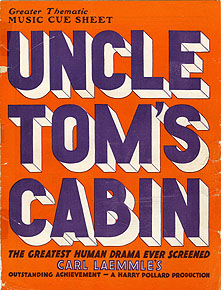|
For their original audiences, silent movies were seldom really silent. From the earliest days exhibitors typically provided live musical accompaniment -- at least a solo pianist or an organist playing a standard repetoire of mood music, but often additional musicians and a specially written score. By the 1920s the big city showing of any major feature film regularly included a small orchestra.
|
 |
For Universal's Uncle Tom's Cabin, the 1927-1928 performances at New York's Central Theatre added a chorus of African American "Jubilee Singers" singing spirituals to accompany the film's original score, written by Dr. Hugo Riesenfeld, who also conducted the singers and musicians at the film's premiere.
When the film had its second "big theatre" opening, at the Criterion in Los Angeles in March, 1928, the "soundtrack" was again supplied by a live orchestra. As Universal prepared to release the film nationally, a 16-page "Thematic Music Cue Sheet" by James C. Bradford was printed to distribute to theaters along with the film's 10 reels. 12 of the booklet's pages consist of short pieces of music (as in the example above). The first two links below allow you to see it with or without images of that music. Bradford does not make clear how closely his arrangement relied on Riesenfeld's score. For instance, according to a New York Times article, Riesenfeld included authentic and previously unrecorded southern "negro melodies" in his score, including a particularly moving one that he chose for the movie's central musical theme, but there's no sign of that song among the 123 pieces of music in the "Cue Sheet."
|
American audiences in the late Twenties soon had another way to hear the movie, as Universal tried to keep up with their rivals at Warner Brothers, which had released The Jazz Singer, the first "Talkie," shortly before the premiere of Pollard's Uncle Tom. To compete with Warner's "Vitaphone," in September 1928 Universal released a new version of the movie, with "movie tone synchronization." You can hear more about that version, and hear excerpts from its soundtrack, at the last link below.
|



